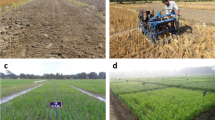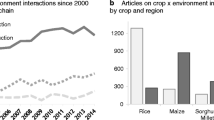Abstract
Background, aims and scope
Food production is essential to life. Modern farming uses considerable resources to produce arable crops. Analysing the environmental burdens of alternative crop production methods is a vital tool for policymakers. The paper describes the production burdens (calculated by life cycle analysis) of three key arable crops: bread wheat, oilseed rape and potatoes as grown in England and Wales using organic and non-organic (contemporary conventional) systems. Resource use (e.g. abiotic and energy) and burdens from emissions are included (e.g. global warming potential on a 100-year basis, global warming potential (GWP), and eutrophication and acidification potentials).
Methods
Crop production was analysed, using systems models, so that the effects of factors like changing N fertiliser application rates or irrigation could be examined. Emissions of nitrate were derived from a simulation model in which soil organic N was driven to steady state so that all long-term effects were properly accounted for. Yield response curves to N were similarly derived from long-term experiments. Crop nutrient inputs and plant protection applications were derived from national survey data and the literature. All major inputs were accounted for including fertiliser extraction, manufacture and delivery; pesticide manufacture; field fuel use; machinery and building manufacture; crop drying, cooling and storage. The current balance of production systems were found from survey data. The weighted mean national production was calculated from a combination of three rainfall levels and soil textures. The system boundary is the farm gate. The functional unit is 1 t marketable fresh weight of each product.
Results and discussion
The primary energy needs for the producing the three main crops were 2.4, 4.9 and 1.4 GJ/t for bread wheat, oilseed rape and potatoes, respectively. When expressed in terms of dry matter, protein or energy, wheat incurred smaller burdens than oilseed rape, which incurred lower burdens than potatoes. The crops do, of course, all play different roles. Organically produced bread wheat needed about 80% of the energy of non-organic, while organic potatoes needed 13% more energy than non-organically produced ones. While pesticide use was always lower in organic production, other burdens were generally inconsistently higher or lower. Land occupation was always higher for organic production. Lower fertiliser use (and hence energy use) in organic systems is offset by more energy for fieldwork and lower yields. Main crop potato energy needs are dominated by cold storage. Reducing the N application rate for bread wheat production reduces energy use and GWP. The optimum for energy is with N at about 70% of the current level. It seems to be lower for GWP, but the sub-models used are beyond their range of reliability. The results are generally of the same order as those from other European studies.
Conclusions
Arable crop production depends heavily on fossil fuel in current major production systems. The emissions causing GWP are very dependent on nitrous oxide, more so than fuel consumption. That, together with emissions of ammonia and nitrate, means that agriculture has a C-N footprint rather than the C footprint that typifies most industrial life.
Recommendations and perspectives
With the large influence of nitrous oxide on GWP, evaluation of nitrous oxide emissions by another method, e.g. crop-soil simulation modelling instead of the more rigid IPCC method would improve the robustness of the analysis. The transition between farming systems was not included in this study, but there could be short to medium term benefits of converting from non-organic to organic methods that should be evaluated. System modelling allows alternative production methods to be readily explored and this greatly enhances LCA methodology.

Similar content being viewed by others
References
Anderson HM, Garthwaite DG, Thomas MR (2002) PUS Report 189: potato stores in GB. Central Science Laboratory, Sand Hutton, York
Anon (1999) Potato storage, FEC2111, Farm energy centre, Stoneleigh Park, Kenilworth
Audsley E (1981) An arable farm model to evaluate the commercial viability of new machines or techniques. J Agric Eng Res 26(2):135–143
Audsley E (1999) Systematic procedures for calculating agricultural performance data for comparing systems. In agricultural data for life cycle assessments volume 1, proceedings of 2nd European Invitational Expert Seminar on Life Cycle Assessment of Food Products, 25-26 Jan 1999, LEI, The Hague
Audsley E, Alber S, Clift R, Cowell S, Crettaz P, Gaillard G, HausheerJ, Jolliett O, Kleijn R, Mortensen B, Pearce D, Roger E, Teulon H, Weidema B, van Zeijts H (1997) Harmonisation of environmental life cycle assessment for agriculture. Final report, concerted action AIR3-CT94-2028, European Commission, DG VI Agriculture, Brussels
Baggott S, Brown LMR, Murrells T, Passant N, Watterson J (2004) UK greenhouse gas inventory, 1990 to 2002. Annual report for submission under the framework convention on climate change, AEA Technology plc, Culham Science Centre, Abingdon, Oxon., OX14 3ED, UK
Beukema HP, van der Zaag DE (1990) Introduction to potato production. Pudoc, The Netherlands
Bishop CFH, Maunder WF (1980) Potato mechanisation and storage. Farming Press, Ipswich, Suffolk
Brooker DB, Bakker-Arkema FW, Hall CW (1992) Drying and storage of grains and oilseeds. Van Nostrand Reinhold, New York, p 450
Cederberg C (1998) Life cycle assessment of milk production a comparison of conventional and organic farming, SIK-Rapport Nr 643. Göteborg University and the Swedish Institute for Food and Biotechnology, Göteborg
Chamen WCT, Audsley E (1993) A study of the comparative economics of conventional and zero traffic systems for arable crops. Soil & Tillage Research 25(4):369–390
Charles R, Jolliet O, Gaillard G, Pellet D (2006) Environmental analysis of intensity level in wheat crop production using life cycle assessment. Agric Ecosyst Environ 113(1–4):216–225
Defra (2004) http://statistics.defra.gov.uk/esg/publications/auk/2004/6-11.xls
Defra (2005) The British survey of fertiliser practice. Fertiliser use of farm crops for crop year 2004, Defra, London
Elsayed MA, Matthews R, Mortimer ND (2003) Carbon and energy balances for a range of biofuels options, project number B/B6/00784/REP, URN 03/836. DTI, Sheffield
Garthwaite DG, Thomas MR, Dawson A, Stoddart H (2005) Pesticide usage survey report 2002: arable farm crops in Great Britain 2004. Pesticide Usage Survey Group, Central Science Laboratory, Sand Hutton, York
HGCA (2003) Wheat quality data, available at: www.hgca.com (accessed 2004)
Lampkin N, Measures M, Padel S (2002-5) 2002-5 Organic farm management handbook, (4th edition) Institute of rural studies, University of Wales, Aberystwyth
MAFF (2000) Fertiliser recommendations for agricultural and horticultural crops (RB209) (7th edition) The Stationery Office, London
MAFF (1992) UK tables of feed composition and nutritive value for ruminants. (Second edition) Chalcombe Publications
McLean KA (1989) Drying and storing combinable crops (2nd Edition) Farming Pres Ltd, Ipswich
Nellist M (1998) Bulk storage drying of grain and oilseeds, research review (38). Home Grown Cereals Authority, London, p 56
Nix JS (2002-5) Farm Management Pocketbook, (33th (2003) edition) The Andersons Centre, Imperial College London, Wye Campus
Robertson GP, Paul EA, Harwood RR (2000) Greenhouse gases in intensive agriculture: contributions of individual gases to the radiative forcing of the atmosphere. Science 289:1922–1925
Röver M, Murphy DPL, Heinemeyer O (2000) Evaluation of conventional and organic agricultural production in relation to primary energy inputs and certain pollution gas emissions, landbauforschung voelkenrode, sonderheft 211. FAL, Braunschweig
Scotford IM, Burton CH, Phillips VR (1996) Minimum-cost biofilters for reducing odours and other aerial emissions from livestock buildings. 2. A model to analyse the influence of design parameters on annual costs. J Agric Eng Res 64(2):155–163
Soil Association (2003) Soil Association organic food and farming report 2003. Soil Association, Bristol
Soil Management Initiative (2005) www.smi.org.uk
Smith JU, Bradbury NJ, Addiscott TM (1996) Sundial: a PC-based system for simulating nitrogen dynamics in arable land. Agron J 88(1):38–43
van der Werf HMG, Petit J, Sanders J (2005) The environmental impacts of the production of concentrated feed: the case of pig feed in bretagne. Agric Syst 83(2):153–177
Weatherhead EK, Danert K (2001) Survey of irrigation of outdoor crops in 2001 England, available at: http://www.silsoe.cranfield.ac.uk/iwe/projects/irrigsurvey/2001%20irrigation%20survey%20results%20-%20england.pdf. Accessed 2005.
Weatherhead EK, Knox JW, Morris J, Hess TM, Bradley RI, Sanders CL (1997) Irrigation demand and on-farm water conservation in England and Wales. Report to Ministry of Agriculture, Fisheries & Food (MAFF) Project OC9219, MAFF, London
Williams AG, Sandars DL, Audsley E (2004) Environmental benchmarks of arable farming. Final report to Defra (CSG15) for Project Number ES0112, Silsoe Research Institute, Silsoe
Williams AG, Audsley E, Sandars DL (2006) Determining the environmental burdens and resource use in the production of agricultural and horticultural commodities. Main report. Defra Research Project IS0205. Bedford: Cranfield University and Defra. Available on www.agrilca.org and www.defra.gov.uk
Author information
Authors and Affiliations
Corresponding author
Rights and permissions
About this article
Cite this article
Williams, A.G., Audsley, E. & Sandars, D.L. Environmental burdens of producing bread wheat, oilseed rape and potatoes in England and Wales using simulation and system modelling. Int J Life Cycle Assess 15, 855–868 (2010). https://doi.org/10.1007/s11367-010-0212-3
Received:
Accepted:
Published:
Issue Date:
DOI: https://doi.org/10.1007/s11367-010-0212-3




